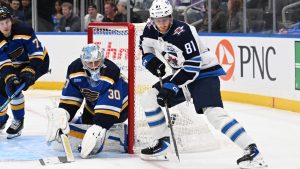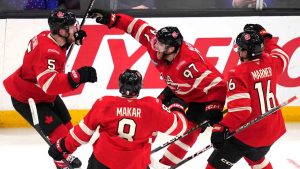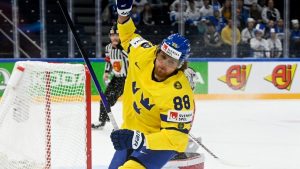In these parts, fall is in the air, the leaves are changing and the smell of a new hockey season is blowing in (or is that just my smelly hockey equipment airing out?).
But as pre-season games are going on, prospects make their case for a roster spot and new lines begin to form, three prominent young NHL stars are still on the sidelines. Don’t call them hold outs though — Elias Pettersson, Quinn Hughes and Brady Tkachuk are still without new contracts and in the midst of negotiations with their teams.
We’re not at a point of no return for any of these guys, though. On the contrary, it’s not unusual for players of their ilk to miss training camp or even all of the pre-season before coming to terms. Heck, there are even a few recent examples of these RFAs missing the beginning of the regular season — and even that doesn’t guarantee disaster.
Here are some recent, notable examples of RFAs who missed the start of camp or the regular season, how their situations were resolved and how they performed in that season. There are a few instances of these difficult negotiations seemingly starting the process of the player leaving town, but even that’s not always the case.
So, I guess what I’m trying to say to Canucks and Senators fans specifically is that it’s not time to panic yet. Easy to say, not so easy to do, I know.
[radioclip id=5208603]
MISSED START OF TRAINING CAMP
Matthew Tkachuk, Calgary Flames, 2019
Calgary’s winger pulled “a classic Tkachuk” in 2019 when he missed the start of Flames camp as he worked on a new contract with the team. An RFA coming off his entry-level deal at the time, Tkachuk had just scored 34 goals and 77 points, and his candidacy for the future captaincy was on track.
How it was resolved: A couple of days after Tampa’s Brayden Point signed a bridge deal (three years, $6.75 million AAV) Tkachuk followed with a bridge deal of his own at three years and a $7 million AAV. After Tkachuk signed, Kyle Connor and Patrik Laine remained as unsigned RFAs (more on them in a second), though both of them resolved their contract disputes by the time the week was out.
How Tkachuk performed that season: Signing about a week before the new season started, Tkachuk missed nearly the entirety of training camp, but was in the lineup for opening night and recorded an assist. He started well, too, running as a point-a-game player for the first quarter of the season. When the year paused in March due to the pandemic, Tkachuk was Calgary’s leading scorer. After struggling through last season, Tkachuk enters 2021-22 in the last year of this contract, after which he’ll be an RFA once again.
Patrik Laine and Kyle Connor, Winnipeg Jets, 2019
These two Jets were the last big RFAs standing after Tkachuk re-signed in 2019 and both came to terms with Winnipeg shortly afterwards. Laine, who stormed into the league as an elite sniper, had just posted a 30-goal season before this contract dispute, but that represented a 14-goal decline from the 2018-19 season. Connor, on the other hand, saw an uptick in production and outproduced Laine in his second NHL season. These two situations played out entirely differently.
How it was resolved: First came Laine, who signed a two-year bridge deal with the Jets at a $6.75 million cap hit. One day later, Connor re-upped with the Jets, but his was a long-term pact, running seven years with a $7.142-million cap hit.
How Laine/Connor performed that season: Both players signed less than a week before the regular season, but they were in the lineup opening night and Laine recorded an assist on a Connor goal. Laine, in fact, got off to a fantastic start to the season with 12 points in his first eight games. But as the year went along, Connor was the player who took a big step up. By the time the March pause happened, Connor led the Jets in goals and points, while Laine posted a very respectable 28 goals in 68 games — though that still wasn’t at a pace equal to either his rookie or sophomore seasons. Shortly after the 2020-21 season began, Laine was traded to Columbus.
Ryan Johansen, Columbus Blue Jackets, 2014
Coming off a 33-goal season (still a career high) Johansen was seeking a big raise, but that was the only strong full season out of his first three in the league. Johansen was seeking a pay day that would have made him one of the highest-paid players coming out of an entry-level contract at the time and the Blue Jackets pushed back. Some agents even thought the player’s side was “mishandling” the negotiation.
How it was resolved: Two days before the start of the regular season, Johansen signed a three-year bridge with Columbus that had a palatable $4 million cap hit. But it was a contentious negotiation, with the team claiming Johansen’s demands amounted to “extortion” and the player’s representatives decrying the public nature of the team’s approach as lacking “integrity.” The whole episode had a major impact on the long-term relationship.
How Johansen performed that season: Johansen followed through with another good year after missing camp. He recorded a point in each of the first 10 games of the season and finished with a career-high 71 points, which remains his best to this day. The following season brought another strong start for Johansen, but he was traded to Nashville halfway through, as the Blue Jackets addressed their need on defence by picking up Seth Jones in return.
Johnny Gaudreau, Calgary Flames, 2016
Gaudreau played two NHL seasons on his entry-level deal and both were electrifying. In the final of those two seasons, Gaudreau posted 30 goals and 78 points that had him on track to be one of the league’s top offensive stars. Teammate and centre Sean Monahan — who Gaudreau outperformed — received a seven-year extension with a $6.375-million cap hit and so Gaudreau was seeking a higher pay day. And why not?
How it was resolved: Just two days before the start of a new season, Gaudreau inked a six-year deal with the Flames that came with a $6.75-million cap hit. That contract is entering its final season in 2021-22 and though Gaudreau has stated he’d like to re-sign with the Flames again, the fact is that this team is at a crossroads now, and the investments they made in this core five years ago never paid off with an extended post-season run. Gaudreau’s trade candidacy will be a hot topic all season.
How Gaudreau performed that season: Scoring just twice in his first 14 games, Gaudreau got off to a slow start, never recovered and finished with one of the worst offensive seasons of his career (though he still led the Flames in points). He did bounce back in years two and three of the deal, before falling back again in 2019-20. What’s interesting is that while, yes, Gaudreau missed Calgary’s training camp, it’s not so easy to say that’s why he struggled in this case. After all, Gaudreau played with Team North America at the World Cup of Hockey that September and led them in scoring with four points in three games.
MISSED START OF SEASON
William Nylander, Toronto Maple Leafs, 2018
At the time of this impasse, Nylander was coming off back-to-back 61-point seasons and the Leafs had just spent up to sign UFA John Tavares from the Islanders in July. Auston Matthews and Mitch Marner still had not signed their second deals, so Nylander’s six-year contract and $6.9 million cap hit seemed to set the tone.
How it was resolved: The Leafs winger took his negotiation as long as it could go, signing on Dec. 1 and right before the 5:00 p.m. deadline. Had a deal not been struck by that time, Nylander would have been ineligible to play the rest of the season. He got back in Toronto’s lineup shortly after, but had already missed the first 28 games.
How Nylander performed that season: This was the worst statistical season of Nylander’s career. He recorded a point in just two of his first 19 games, finished with seven goals and 27 points in 54 games (a 41-point pace over 82 games). The weird thing is that his underlying numbers were still pretty good — Nylander led all Leafs forwards in 5-on-5 Corsi and expected goals percentage. He did have a poor personal shooting percentage, and Toronto’s team shooting percentage tanked when he was on the ice. So, some bad luck did conspire against him that year, but it also took him a while to find his legs and 2018-19 was clearly Nylander’s most frustrating season to date.
Ryan O’Reilly, Colorado Avalanche, 2013
At this stage, O’Reilly was coming off his entry-level deal and a career-best offensive season at the time, to go along with the fact he was an emerging, elite defensive centre. He wanted to get an appropriate raise. The Avs, meanwhile, weren’t eager to sign an inflated contract that could throw off the cap balance of a young team.
How it was resolved: Since this was a lockout-shortened season, the usual Dec. 1 deadline O’Reilly would have needed to sign by in order to play wasn’t in place. And, in fact, it wasn’t the Avalanche who struck this deal. Rather, it was the Calgary Flames who signed O’Reilly to an ill-advised offer sheet on Feb. 28 — two years with a $5-million cap hit. The thing is, since O’Reilly had played some KHL games while he was negotiating with the Avs, had Colorado not matched the offer sheet, the Flames would have needed to give up the first- and third-round compensation, but O’Reilly then would have needed to pass through waivers, where he almost certainly would have been claimed by someone else. This contract made O’Reilly’s next negotiation with the Avs another difficult one, resulting in another two-year pact and an eventual trade to Buffalo.
How O’Reilly performed that season: O’Reilly posted 20 points in 29 games, the best rate of his career to that point, and was a team leader in underlying possession stats. However, his role was cut back somewhat, with his ice time dropping by a little over one minute per game.
P.K. Subban, Montreal Canadiens, 2013
Coming off his entry-level deal, Subban was seeking a long-term pact with the Canadiens, while Montreal was thinking more short term. Subban’s best was a 38-point season at the time, though his goal total had been cut in half from 2010-11 to 2011-12.
How it was resolved: A few days into the lockout shortened season, Subban signed on Jan. 28 for two years and a $3.1 million cap hit, then played his first game on Feb. 2, which meant he missed the first six games of the season. This bridge contract set the tone for another difficult negotiation in 2014 that ultimately led to his departure from the organization.
How Subban performed that season: Here is a great example of how missing the start of a new season doesn’t guarantee full doom and gloom. Subban started right away with a four-game point streak as soon as he hit the ice and went on to log 38 points in 42 games, which was a huge step up in his per game point production. Subban went on to win the Norris Trophy in 2013 and he’s never matched the 0.9 points per game pace he scored at this season.
Jacob Trouba, Winnipeg Jets, 2016
Trouba’s slow but inevitable walk out of Winnipeg began with a trade request in May of 2016, citing a desire to have top-four minutes on the right side, a role the Jets couldn’t provide with their depth of right-shot defencemen. At the same time, Trouba was in need of a new contract following the expiration of his entry-level deal.
How it was resolved: With a Dec. 1 deadline to play looming, Trouba came to terms with the Jets on Nov. 7 — a two-year bridge. The writing was on the wall, though, and after this two-year deal expired, Trouba inked another one-year pact with the Jets and it seemed he was trying to slow walk his way to free agency. After the 2018-19 season, one year before he would have become UFA eligible, the Jets traded Trouba to the Rangers.
How Trouba performed that season: Trouba missed the first 15 games of Winnipeg’s season, but logged 23:14 of ice time in his first game back. By the time the season finished, Trouba had increased his role around the board, and his average ice time rose by nearly three minutes per game. He also posted a career-high 33 points in a career-low 60 games to that point.
[relatedlinks]



 2:51
2:51